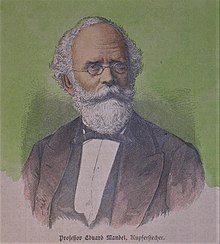Eduard Mandel
Eduard Mandel (born February 15, 1810 in Berlin , † October 20, 1882 in Berlin) was a German engraver .
Life
At the age of 14, Mandel became a student of the map engraver Johann Karl Mare (1773-1835) and two years later moved to the studio of the copper engraver Ludwig Buchhorn . At the end of his training there, Mandel made a portrait of King Friedrich Wilhelm III based on his own template in 1830 . Then he found his own style with his work “ The Warrior and His Child ” (based on a painting by Theodor Hildebrandt ). Highly praised by the official art critics, the Prussian Art Association commissioned him with several works, the most important of which was "Die Lurlei" after Carl Joseph Begas . In 1839 Mandel completed this sheet and according to their own admission, the painters Karl Ferdinand Sohn and Hermann Wislicenus were later inspired by it.
In 1837 the Berlin Academy appointed him a member. In the spring of 1840 Mandel went to the École des Beaux-Arts in Paris , where he became a student of Louis Pierre Henriquel-Dupont and Auguste Gaspard Louis Desnoyers . One of his first works was also created here, the "Italian Shepherd Boy" (after Pollack).
Returning to Berlin in 1842, Mandel continued his work and was appointed lecturer at the local art academy and professor at the copper engraving school. Robert Trossin deserves special mention as his pupil . In 1856 Mandel was appointed director of the copperplate engraving at the art academy. When teaching was stopped during the Franco-Prussian War , Mandel resigned from his offices and retired to private life. His best-known work, which was created shortly before his death, is an engraving after the Sistine Madonna by Raphael. Almond is considered one of the leading masters of Berlin engraving. He was famous for his strict line engraving. So his art asserted itself against the competition of more modern forms of reproduction such as lithography and photography.
He died at the age of 72 on October 20, 1882 in Berlin, his grave was in the St. Marien and St. Nikolai Cemetery I in the Berlin district of Prenzlauer Berg .
Honor
On January 24, 1860, he was accepted into the Prussian order “ Pour le mérite for science and the arts ”.
Since 1923, a newly established street in the Prenzlauer Berg district of Berlin has been called Mandelstraße .
Works (selection)
- Self-portrait (1841, after Anthonis van Dyck )
- Self-Portrait (1843, after Tizian )
- King Friedrich Wilhelm IV. (Portrait)
- Queen Elisabeth of Prussia (portrait)
- King Charles I of England (1850, after Anthony van Dyck)
- King Frederick the Great
- Madonna Colonna (1855, after Raffael )
- Ecce homo (1855, after Guido Reni )
- Portrait of a young man (1860, after Raffael)
- Madonna della Sedia (1865, after Raffael)
- La Bella (1868, after Titian)
- Madonna Panshanger (1872, after Raffael)
- Maria and Johannes (after Bernhard Plockhorst )
- The adulteress (after Bernhard Plockhorst)
- Sistine Madonna (Raffael)
- The warrior and his child (1835, after Theodor Hildebrandt )
- Italian shepherd boy (1840, after Pollack)
literature
- Lionel von Donop: Mandel, Eduard . In: Allgemeine Deutsche Biographie (ADB). Volume 20, Duncker & Humblot, Leipzig 1884, pp. 166-170.
- Sylva van der Heyden: Mandel, (Johann August) Eduard . In: Bénédicte Savoy, France Nerlich, France (ed.): Paris apprenticeship years. A lexicon for training German painters in the French capital . Volume 1: 1793-1843 . Berlin / Boston 2013, pp. 190–193.
Web links
Individual evidence
- ↑ a b The Order pour le merite for science and the arts. The members of the order, Volume I (1842–1881), page 216, Gebr. Mann-Verlag, Berlin 1975
| personal data | |
|---|---|
| SURNAME | Almond, Eduard |
| BRIEF DESCRIPTION | German engraver |
| DATE OF BIRTH | February 15, 1810 |
| PLACE OF BIRTH | Berlin |
| DATE OF DEATH | October 20, 1882 |
| Place of death | Berlin |

